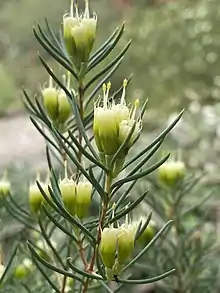| Homoranthus montanus | |
|---|---|
 | |
| Homoranthus montanus in the ANBG | |
| Scientific classification | |
| Kingdom: | Plantae |
| Clade: | Tracheophytes |
| Clade: | Angiosperms |
| Clade: | Eudicots |
| Clade: | Rosids |
| Order: | Myrtales |
| Family: | Myrtaceae |
| Genus: | Homoranthus |
| Species: | H. montanus |
| Binomial name | |
| Homoranthus montanus | |
 | |
| Occurrence data from AVH | |

Homoranthus montanus is a plant in the myrtle family Myrtaceae and is endemic to a small area in southern Queensland. It has narrow leaves and up to one to six small tubular, cream-coloured flowers arranged in leaf axils near the ends of the branchlets. As the flowers age, they turn red.[2][3]
Description
An erect shrub growing to 1.2 m (4 ft) tall. The leaves are 0.8 mm (0.03 in) thick. Flowers and fruits sporadically throughout the year, mostly October to November.[3]
Taxonomy and naming
Homoranthus montanus was first formally described in 1991 by Lyndley Craven and S.R Jones and the description was published in Australian Systematic Botany.[4] The specific epithet (montanus) is a Latin word meaning "of mountains".[5]
Distribution and habitat
Restricted to Ballandean and Mount Jibbinbar Queensland. Grows on shallow sandy soils in woodland and heath on and around granite outcrops.[3]
Conservation
Homoranthus montanus is listed as "vulnerable" under the Australian Government EPBC Act.[2] A very rare species known from two small populations. IUCN (2010) considered vulnerable.[3]
References
- ↑ "Homoranthus montanus". Australian Plant Census.
- 1 2 "Approved conservation advice for Homoranthus montanus" (PDF). Australian Government Department of the Environment. Retrieved 24 August 2018.
- 1 2 3 4 Copeland, Lachlan M.; Craven, Lyn A.; Bruhl, Jeremy J. (2011). "A taxonomic review of Homoranthus (Myrtaceae: Chamelaucieae)". Australian Systematic Botany. 24 (6): 351. doi:10.1071/SB11015.
- ↑ "Homoranthus montanus". APNI. Retrieved 24 August 2018.
- ↑ Brown, Roland Wilbur (1956). The Composition of Scientific Words. Washington, D.C.: Smithsonian Institution Press. p. 536.
